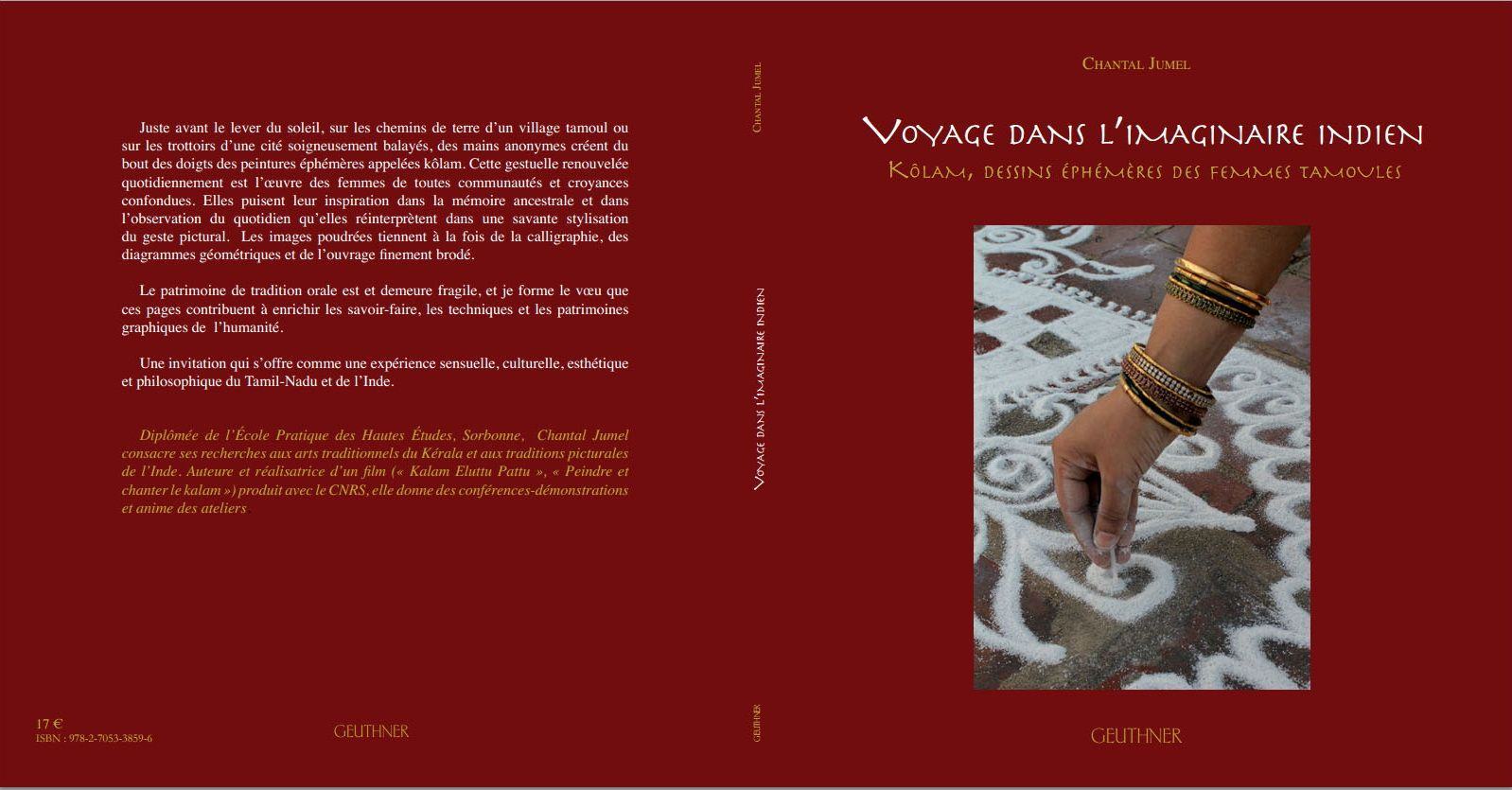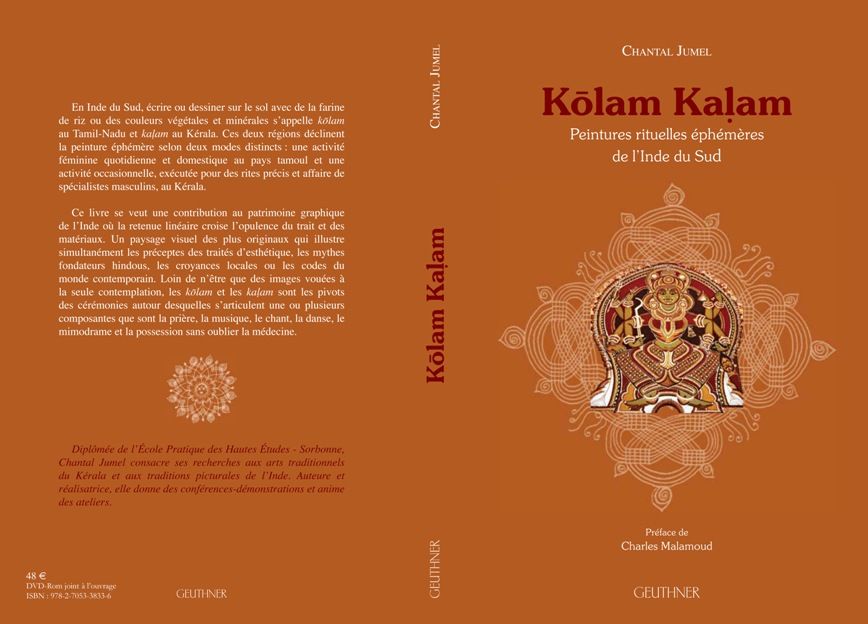
Books and articles
Graduated from ECOLE PRATIQUE DES HAUTES ETUDES, PARIS SORBONNE University.
JUMEL, Chantal, Peintures rituelles et éphémères du Tamil-Nadu et du Kérala (Ritual and ephemeral paintings of Tamil-Nadu and Kerala)
Supervision : Marie-Louise Reiniche
DEP 564 Date : 20/12/2002 2 vols.
Bibliothèque des Sciences religieuses
46, rue de Lille, 75007 Paris, France
Téléphone : +33 (0)1 53 63 61 28
https://www.ephe.fr/
My books
VOYAGE DANS L’IMAGINAIRE INDIEN, Kôlam, dessins éphémères des femmes tamoules.
(Journey into graphical India, Kôlam, ephemeral drawings of Tamil women.)
- Author: Chantal Jumel
- Publisher: Geuthner (French – Illustrations)
- The book can be ordered directly from Geuthner publications
- Phone: +33 1 46 34 71 30

Summary:
"In South India just before sunrise, anonymous hands use their fingertips to trace ephemeral designs on the dirt paths of a Tamil village or the carefully swept city pavements. This ritual is the daily task of women from a variety of communities and faiths. They take their inspiration from an ancestral tradition and by observing everyday life, which they then reinterpret through a skilful pictorial stylisation. These powdered designs suggest calligraphy, geometrical diagrams and fine embroidery. This oral tradition is fragile and it is my wish that these pages become a contribution to the know-how, technique and graphical heritage of humanity. This is an invitation to take part in a sensory, aesthetic and philosophical journey to India and in particular the culture of Tamil Nadu."
KŌLAM et KALAM, Peintures rituelles éphémères de l’Inde du Sud
(KŌLAM and KALAM, South Indian ephemeral and ritual paintings)
- Author: Chantal Jumel
- Recipient of the SCAM (Civil Society for Multimedia Authors) award 2010
- Publisher: Geuthner (French – Illustrations – Book with a DVD Video)

Summary:
South Indian auspicious thresholds and ritual designs.
Ephemeral drawings applied daily on the threshold of the houses or in temples are called kolam in Tamil-Nadu and kalam in Kerala and bear testimony to the richness of Indian graphical patrimony. These two states decline ephemeral painting according to two different modes: a daily and domestic feminine activity in the Tamil country and an occasional activity executed for specific rituals by male specialists in Kerala.
The book is available at Geuthner – Phone: +33 1 46 34 71 30
Articles
- "Flowers and leaves, the Indian way", Blumenhaus magazine, November 2020 pages 128-135.

- Mandana du Rajasthan, Voyage dans l’univers graphique des femmes, “Rencontre avec l’Inde » Tome 43, n°1, 2014 Disponible ici, pages 94-10
- Kolam: When Hands are Drawing, Sahapedia
- "A journey through graphical India" Arts & Cultures N° 16 / 2015, Coédition Musées Barbier-Mueller / Somogy éditions d’Art.
- Kolam, when hands are drawing, HUM Magazine August 2012
- Hommage à l’Inde des femmes: Kôlam, quand les mains dessinent « Rencontre avec l’Inde » Tome 40, N°2, 2011
- Kolam, images éphémères des femmes tamoules « Nouvelles de l’Inde » Numéro 389 – Mars-Avril 2008
- Les Kolams « Nouvelles de l’Inde » Numéro 340 – Mai-Juin 2002
- Bhaumika Citra : Threshold Art « The India Magazine » Vol.15 June 1995
- Bhaumika Citra ou l’art de peindre sur le sol « Nouvelles de l’Inde » Numéro 296 – Nov-Déc 1994
Radio
FRANCE CULTURE, “Cultures de soi, cultures des autres” avec Catherine Clément. "Kolam, ou comment peindre la terre" avec Chantal Jumel
Film
Audio-visual portal of CNRS (French National Council of Scientific Research).
Reference of the documentary Kalam Elluttu Pattu : Peindre et chanter le Kalam – Painting and singing the Kalam, by Chantal Jumel, 1996, 23’, CNRS AV – for rental or purchase.
"In South India, in the state of Kerala, a tradition of ephemeral painting dedicated to the gods continues from father to son. M. Kurup goes to temples and houses in order to perform an auspicious ritual called Kalam eluttu pattu. He will be drawing the painting directly on the ground. At home, he crushes the mineral and vegetable for the coloured powders to be used for the graphic representations. Mr Kurup hands down his knowledge of forms, colours and ritual songs to his son who acts as his assistant. Both invoke the presence of the goddess through mantra and mudra then sing her qualities and deeds with the accompaniment of an Idekka drum"